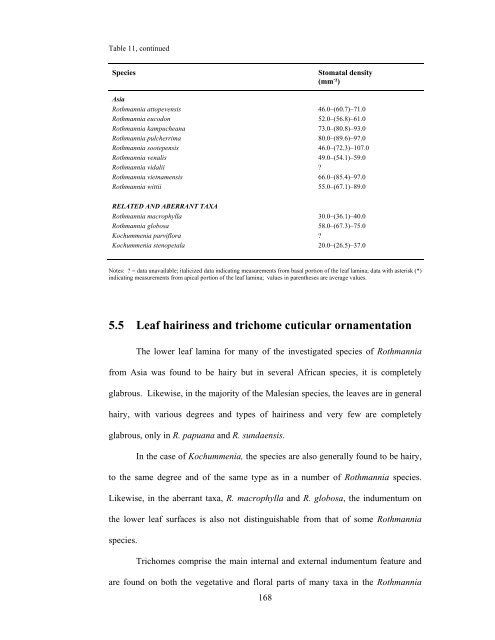Chapter 5.pdf - DSpace@UM
Chapter 5.pdf - DSpace@UM
Chapter 5.pdf - DSpace@UM
Create successful ePaper yourself
Turn your PDF publications into a flip-book with our unique Google optimized e-Paper software.
Table 11, continuedSpeciesStomatal density(mm - ²)AsiaRothmannia attopevensis 46.0–(60.7)–71.0Rothmannia eucodon 52.0–(56.8)–61.0Rothmannia kampucheana 73.0–(80.8)–93.0Rothmannia pulcherrima 80.0–(89.6)–97.0Rothmannia sootepensis 46.0–(72.3)–107.0Rothmannia venalis 49.0–(54.1)–59.0Rothmannia vidalii ?Rothmannia vietnamensis 66.0–(85.4)–97.0Rothmannia wittii 55.0–(67.1)–89.0RELATED AND ABERRANT TAXARothmannia macrophylla 30.0–(36.1)–40.0Rothmannia globosa 58.0–(67.3)–75.0Kochummenia parviflora ?Kochummenia stenopetala 20.0–(26.5)–37.0Notes: ? = data unavailable; italicized data indicating measurements from basal portion of the leaf lamina; data with asterisk (*)indicating measurements from apical portion of the leaf lamina; values in parentheses are average values.5.5 Leaf hairiness and trichome cuticular ornamentationThe lower leaf lamina for many of the investigated species of Rothmanniafrom Asia was found to be hairy but in several African species, it is completelyglabrous. Likewise, in the majority of the Malesian species, the leaves are in generalhairy, with various degrees and types of hairiness and very few are completelyglabrous, only in R. papuana and R. sundaensis.In the case of Kochummenia, the species are also generally found to be hairy,to the same degree and of the same type as in a number of Rothmannia species.Likewise, in the aberrant taxa, R. macrophylla and R. globosa, the indumentum onthe lower leaf surfaces is also not distinguishable from that of some Rothmanniaspecies.Trichomes comprise the main internal and external indumentum feature andare found on both the vegetative and floral parts of many taxa in the Rothmannia168
















